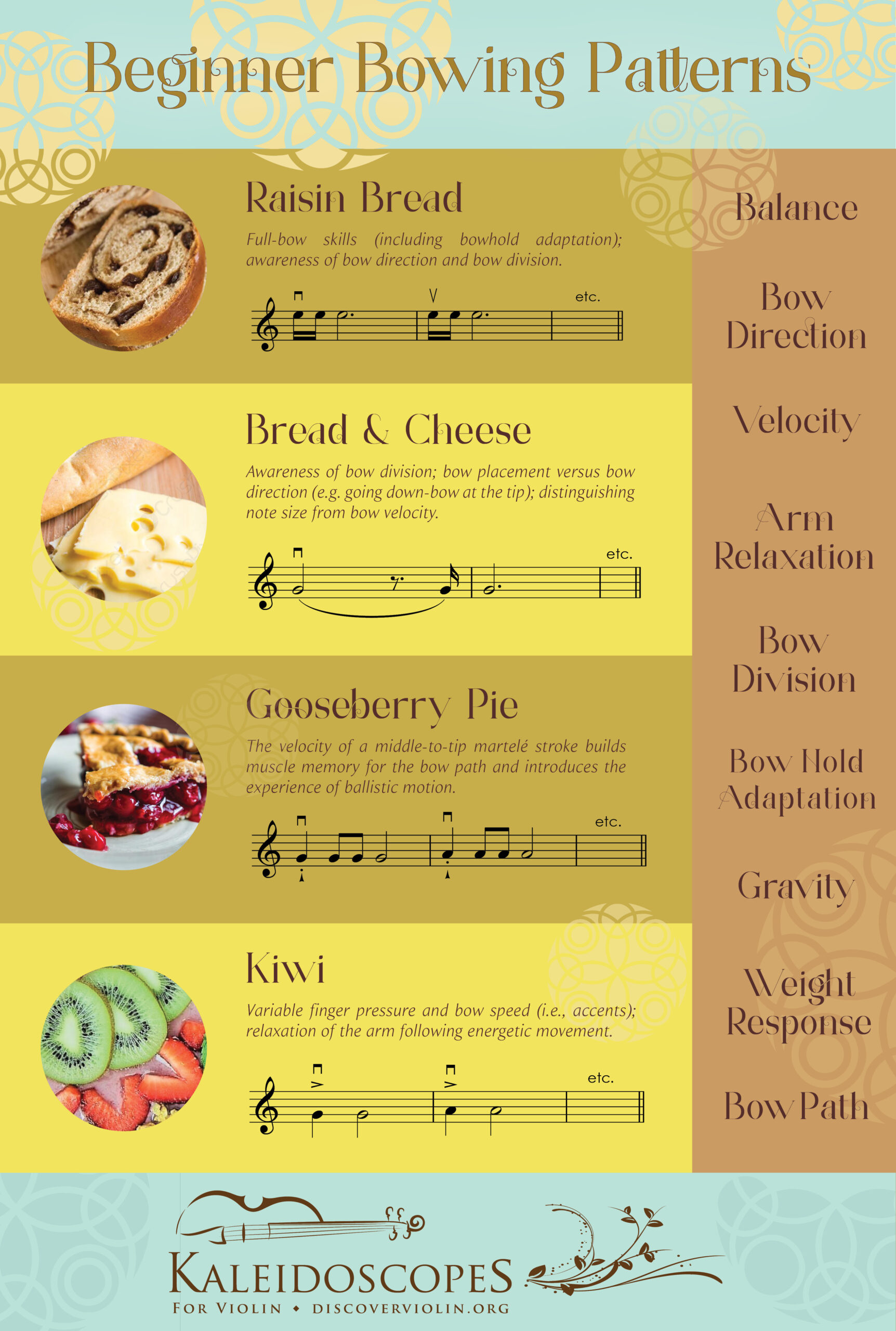Inspired by Sally O’Reilly, I have been introducing more advanced bowing patterns while my students are still in Book 1 (rather than waiting until these patterns show up in the repertoire). After a few years of doing this, it has made a dramatic difference in my students’ bowing comfort and facility.
It would be easy to assume that bowing patterns are just more of what we all grew up with: Pepperoni Pizza, Run Pony, etc.
But as long as bowing patterns are tied to rhythm, the constraints of melody and meter tend to prevent students from fully experiencing the gesture.
Focus on Kinesthetic Experience
The real opportunity offered by the patterns is for the beginner to fully experience the physicality of various motions on the violin.
Kaleidoscopes for Violin
Summer Session
TEACHER TRAINING

Teaching balance, movement, and tonal understanding through guided discovery
This includes fully experiencing bow direction, weight, balance, velocity, bow path, the adaptation of the bowhold over the length of the stroke, and much more.
So in this particular area of technique development, if you are focused on teaching the rhythm, you may be missing the greatest opportunity, which is helping the student experience the motion itself.
Each bowing pattern illuminates a different kinesthetic experience. Mastering the elements of this experience in an embodied way is what will allow the student to execute the motion gracefully.
The physical knowledge and awareness students obtain with each pattern has a multiplying effect across all the exercises.
So over just a few months, students develop a remarkable balance, skill, and control with the bow that will consistently rival that of a typical Book 4 player with years more experience.

An Example: Bread & Cheese
One of my favorite bowing patterns is the dotted rhythm pattern, which my students and I call “Bread and Cheese.” We speak this rhythmically, BREAD, andCHEEEEESE, so that the sound of the words matches the sound of the rhythm.
There are a variety of conceptual and kinesthetic learning opportunities in this experience:
- Students discover that bow direction is separable from bow placement. (Students starting every down-bow at the frog is a clear example of how these two notions are fused together until we help distinguish them.)
- Students try to use a rapid bow on the tiny note because it seems energetic. But this creates an accent and an overly long note. What this note actually requires is a normal bow speed and very little bow. It is the short duration of the note that creates the impression of energy and velocity.
- Students have to overcome their instinctive desire to go up-bow at the tip. The ability to override one’s initial impulse is called response inhibition, and is part of executive function … one of the ways in which playing violin helps to develop cognitive flexibility and emotional maturity.
- The full bows are an opportunity to blend ballistic (free) movement with managed (sustained) movement. The ballistic element makes it easier to guide the bow path and provides a sense of graceful sweep, while the sustained element carries the motion through to the tip.
- The rapid change at the tip is an opportunity to practice relaxation during a bow change that is somewht challenging because of its speed.
The bowing skill and awareness they get from Bread & Cheese extends into their pieces … and meanwhile they’re getting so much practice that this tricky skill will be quick and easy for them by the time they get to Witches Dance (in Suzuki Violin Book 2).
Beneath Appearances
The skills being developed by the bowing patterns are often not what they might initially seem.
For example the Kiwi pattern would appear to be working on accents, but this is not its main purpose (although that is a useful added benefit). Rather, it serves to develop variable bow pressure and timing, which is the foundation for adjusting bow weight to create a beautiful tone.
Related to this, the student must discover that they can use strong exertion in two aspects (pressure and velocity) while remaining relaxed in other dimensions (the back fingers of the bow hand and the opposing muscles of the arm) — since the accent is followed by a long, relaxed stroke and a bow change.
As with Bread and Cheese pattern, this distinction builds cognitive flexibility and greatly enhances the student’s overall physical awareness and skill.
How to Use the Bowing Patterns
I have students practice three different scales a day with bowing patterns on each one. Ideally, the student should practice their newest bowing pattern on a relatively familiar scale. Conversely, they should use already-familiar bowing patterns to “stress test” their newest scales. Varying the left-hand pattern enhances the automaticity of students’ bowing technique, while the distraction of the bowing pattern deepens students’ mastery of scales.
With daily practice on scales and bowing patterns, your students will be much more proficient in playing various keys. This in turn will make it easy for them as the repertoire uses more advanced keys and, eventually, changes key within the piece.
You can find most of the Book 1 bowing patterns (and a few Book 2 patterns) at the Kaleidoscopes channel on YouTube, http://youtube.com/discoverviolin. These are student-oriented videos, so they focus on only the primary teaching points. A more comprehensive list of teaching points for each pattern is found in the the Kaleidoscopes Book 1 Teacher Guide, in the Parent Book II: Playing with the Violin & Bow. The patterns and principles behind them are covered in greatest depth in the Kaleidoscopes Book 1 Workshop: The Well-Rounded Violinist.
These bowing patterns will give your students some impressive bow technique and facility right from the start. I hope you enjoy them!
